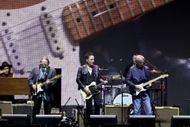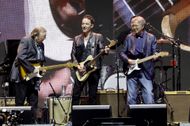The Wallflowers originated in the city of Los Angeles in 1989 as a roots-rock band when Jakob Dylan, son of Bob Dylan, and guitarist Tobi Miller co-founded the band. Though the lineup has changed several times throughout the years, the core member of the project has continued to be Jakob Dylan, who composes the songs and owns the popular sound of the group.
Their debut album, simply titled their name, The Wallflower, in 1992, was not even a fraction of what they could have been until things drastically changed with Bringing Down the Horse in 1996, an album that would make them into mainstream rockers through evergreen songs such as One Headlight and 6th Avenue Heartache.
It is interesting to note that One Headlight did not officially enter the Billboard Hot 100 since it was not sold as a commercial single in the United States, but by the 1990s it would come to be regarded as one of the most iconic rock anthems of the decade and would earn the band two Grammy Awards in 1998, including Best Rock Song.
Their next album, Breach, came out in 2000 and gave them Sleepwalker, which was their sole entry on the Hot 100 at 73. Amidst changes in the landscape of rock, Jakob Dylan maintained an active presence in the Wallflowers despite breakups and hiatuses, renewing the project in 2012 with Glad All Over and once again at the end of the decade with Exit Wounds, delivered in 2021.
Today, the Wallflowers are the evidence of how Jakob Dylan is able to adjust himself to the modern trends in classic rock music by connecting the classic style of rock music, telling about the stories, as well as the modern style that makes this music interesting and up-to-date.
Disclaimer: This article contains the writer's opinion. Reader's discretion is advised!
Here are the top 6 The Wallflowers songs of all time
In general, these six songs show what has kept The Wallflowers in the mix for so long. Each one shows Jakob Dylan's great skill in writing songs and the band's way of blending classic rock sounds with their true, earthy style. From big hits to soft songs that fans love, these tracks prove why The Wallflowers are still important and liked by people who like smart, well-made rock music.
1) One Headlight
When The Wallflowers dropped One Headlight as a track on the 1996 album Bringing Down the Horse, the band did not release yet another rock single; they delivered a song that embodied both a mood and an era, a time and place where people were exploring broken dreams and meaning.
The album was recorded at the iconic Sunset Sound and House of Blues Studio in California and produced by T Bone Burnett, which turned out to be a breakthrough for Jakob Dylan and the bandmates Michael Ward (guitar), Rami Jaffee (keys), Greg Richling (bass), and Mario Calire (drums).
It is the distinctive sound Ward makes with his haunting guitar riffs and Jaffee with his emotionally charged Hammond B3 organ that forms a rich soundscape behind the thoughtful lyrics, which is the sound of this song.
Such lines as the personnel call of the song, "Hey, come on, try a little and Nothing is forever / There is got to be something better than in the middle," allude to the call of good and hope even in times of despair.
The song was called One Headlight, and it not only remained in the airwaves, it dominated them, as the song ranked at the top in Billboard Modern Rock, Mainstream Rock, and Adult Top 40 charts, and it also won the Grammys under the Best Rock Song category and the Best Rock Performance by a Duo or Group with Vocal categories.

The Ken Fox-directed video that presents Dylan leading a gloomy procession throughout the empty streets of the city ideally fits with the idea of desolation, beauty, and perseverance in the song. Today, some decades later, One Headlight remains a sign of The Wallflowers' talent to bring the nostalgia of classic rock and the timelessness of poetic narratives together.
Read More: Top 6 unforgettable Aerosmith stage performances of all time
2) 6th Avenue Heartache
On the catchy alt-rock song and single 6th Avenue Heartache by The Wallflowers, released as part and parcel of their 1996 album Bringing Down the Horse, they did more than provide people with an easy dose of this or that The Wallflowers alt-rock song and single; they provided a dose of urban Americana with interesting dots of colorful storytelling.
A result of the legendary T Bone Burnett producing and it being recorded at both Sunset and House of Blues Studios in Los Angeles is the evocative songwriting by Jakob Dylan, coupled with the inimitable backing vocals of Adam Duritz, which gives the song a wistful quality.
Michael Ward, Rami Jaffee, Greg Richling, and Mario Calire then composed the band, contributing their parts to the overall sound of the album, with the former described as warm yet sad, and indeed, the song 6th Avenue Heartache is a portrait of transient relationships and a jaded urban existence, where, as it turns out, Dylan was inspired by an image of a homeless man he used to see regularly in the streets around his apartment in New York.

The line "And the same black line that was drawn on you / Was drawn on me" is evidence of the fact that Dylan himself felt lost during his touring escapades. The second verse, "And the same black line which was drawn on thee / Was drawn on me / Now it has drawn me in," obscures the distinction between the plight of the busker and the drift of the chanteuse herself.
Reaching number 8 in the Billboard Modern Rock Tracks and also getting constant airplay, the song established the legacy of the album, as well as solidified The Wallflowers' place in the rock revival of the 90s, showing that sometimes it is those stories we hear every day that are the best to turn into eternal music.
3) Love is a Country
By the time The Wallflowers released Glad All Over in 2012, it had been seven years since the band released a studio album, and it featured the band with a slightly altered sonic palette. Tucked into it are the dreamy folk-rock leanings of Love Is a Country, which nonetheless still reflects the considered songwriting of the band.
Love is a Country has a lamenting feel and vivid imagery. Phrases such as "Love is a country better crossed when you're young" and "I am tired of waiting for nothing to come" are a hit as they tap the listeners in a bittersweet road-movie atmosphere. This lends a classical touch to the song because, despite the raw, grating voice, the harmonica and gentle guitar chords hum softly in the background.
The song did not chart especially well but did secure the position in which The Wallflowers established themselves as a group with the ability to combine intimate lyrics with subtle arrangements as a reminder to the fans that Jakob Dylan possesses more songwriting skills than his now well-known last name.

The song has grown over the years to be one of those hidden treasures in their catalog, and this is a testament that even after many years, the band still has new audiences that listen to their musical works.
Read More: 6 best Led Zeppelin stage performances of all time
4) Letter from the Wasteland
Considerable examples of Jakob Dylan creating songs that sound like sleepless declarations under the streetlamp may be found on The Wallflowers song, entitled, Letter from the Wasteland from the 2000 album, Breach.
Although the album did not see the band going back to the huge mainstream success they achieved with Bringing Down the Horse, it demonstrated Dylan exploring further into harsh, introspective songwriting. In this song, he says such things as, "Now I send back letters from the wasteland home" and "Did you... think you were the only one that's been let down?," words that have a pang of lost contact and a constant, agitated quest for purpose.
In contrast to the radio-friendly songs of the band, Letter from the Wasteland exists somewhere in that no man's land between loneliness and hope. It is a song people continue to love due to its sincerity of words and how it encapsulates how the Wallflowers could use their Americana roots to invite a newfound sense of yearning.
It got quite favorable in their collection over the years. It is proof of how sometimes the best lasting song is not a song yelled, but a song rather hissed.
5) Sleepwalker
Sleepwalker is one of the highlight moments of The Wallflowers' third studio album, Breach (released in October 2000), where Jakob Dylan demonstrates his ability to incorporate poetic text into the songwriting frequently heard on the radio. The album was co-produced by Michael Penn and Andrew Slater, with recording done at such legendary locations as Village Recorder in Los Angeles, which has a rich history of music production.
Although Breach did not achieve as much commercial success as their other breakthrough albums, their song Sleepwalker still managed to secure a decent place, having reached the 26th position on the Modern Rock Tracks of Billboard.
The hypnotic riff and the layers of sound production of the song reverberate with the theme of half-awakened life. He sings, "He is just a sleepwalker / He is just a dream talker" in the chorus; that hysterical feeling that he is walking around the city, dark streets, no purpose in mind.
The song itself is not a chart-topping smash but rather has gained irrevocable credit through the years because of its playful lyrics and The Wallflowers' trademark sound of solid guitar lines and emotional delivery, making the band one to be firmly remembered in the age of the musical trends changing around them.
6) Heroes
When The Wallflowers made their own version of David Bowie's Heroes in 1998, they did more than just cover the song. They gave it a new kind of spark for big hit movies and linked it well with the action and drama in Roland Emmerich's Godzilla.
It was a production by Andrew Slater, who had previously collaborated with the band extensively, and it toned back some of Bowie's epic, anthemic style and gave it a more thoughtful, more roots-rock sensibility that matched well with his earnest, almost gritty voice.
The original, written during his Berlin phase in 1977 with Brian Eno, was awash with presentiments of the Cold War and yearning, eternalized in the phrase, "We can be heroes, just for one day." The Wallflowers left that quip in place but placed a more demure, almost wistful, twist on it that suited the alternative rock airwaves of the late 90s.
Their version reached a different audience, as it even reached No. 43 on Billboard Mainstream Rock and No. 51 on Modern Rock Tracks. Doug Aitken directed the music video and combined shots of Godzilla destroying cities with the band playing in a cavernous hangar that was supposed to be in the huge footprint of the monster.

Godzilla received mixed reviews, but its soundtrack, which included other late-90s names such as Jamiroquai and Rage Against the Machine, made the cover by The Wallflowers one of the most played tracks. Ultimately, their version of Heroes gave the immortal words by Bowie a new sharpness, and once again, great songs never go to waste, even in the damp shadow of a behemoth flick.
In all, The Wallflowers' song list shows a band that made its mark in US rock with true songcraft and a sound that mixes old styles with new. As years passed, they kept to their direct, warm way but let in small shifts and growth. Even with changes in the group and shifts in music styles, they kept their realness in good music playing and Jakob Dylan's simple stories. This shows that being steady and real can create a strong history in rock music.
Keep reading SoapCentral for more informative content!
Also Read: 7 best Eric Clapton songs of all time
